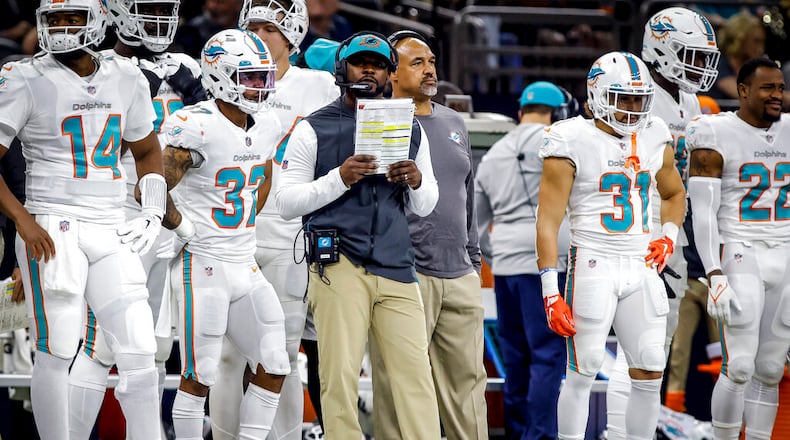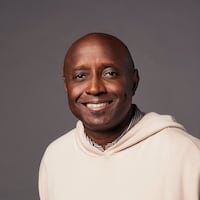Former Dolphins coach Brian Flores filed a lawsuit in federal court accusing the NFL and three of its teams of racial bias in hiring and firing decisions. In response, the NFL released a statement in which it claims that diversity is “core to everything we do.” I wonder if the author of that line kept a straight face while typing it.
The league also claimed that Flores’ claims are “without merit.” The NFL must have worked hard to vet those allegations in the hours between when Flores’ attorneys filed the lawsuit and the league released its statement. Nothing to see there.
The NFL knows it has a problem. Commissioner Roger Goodell has said he’s not happy about the lack of Black coaches. Troy Vincent, the NFL vice president of football operations, acknowledges a “double standard” for judging those coaches. Yet the league keeps going backward, both with hiring Black head coaches and firing those who do get the job even when they beat expectations.
Nzinga “Zing” Shaw has seen the NFL’s diversity efforts up close. She worked in the league office from 2007-10 and served as human-resources liaison for the diversity council chaired by Goodell. Shaw said she believes the efforts of Goodell and others in the NFL are sincere, but the results show that they’ve failed.
“We can tell the story however we want to, but at the end of the day, the numbers are the numbers, and somebody has to be accountable for that,” said Shaw, president of TurnkeyZRG, an executive recruitment firm for sports, entertainment, music and media.
The numbers say that the candidate pool for NFL head coaches, ex-players, is majority Black: about 70% of NFL players and more than half of NCAA players. Black coaches have beaten expectations when they get the chance. But the people hired to be head coaches are overwhelmingly white: 27 of 28 current head coaches, with positions still open as of Friday at Minnesota, Miami, Houston and New Orleans.
White coaches have been hired for five of the nine openings this cycle. Two Black coaches were fired: Flores (Miami) and David Culley (Houston). That leaves one Black coach, Pittsburgh’s Mike Tomlin. That’s two less Black coaches than when the NFL adopted the so-called Rooney Rule in 2003.
“They have regressed,” Shaw said of the NFL. “It means this policy is not working.”
Shaw said racial bias in hiring isn’t limited to the NFL or the sports industry. She’s spent much of her career trying to help organizations solve it. Since leaving her job with the league, Shaw has been a diversity and inclusion executive for the Edelman public relations firm, the Hawks, Starbucks and the Marsh McLennan professional services firm.
Shaw said the Rooney Rule guarantees Black candidates an audience, but the NFL should go further if it actually wants to increase the number of Black coaches.
“There is not a hiring quota or preference given to these underrepresented candidates to actually get the jobs,” Shaw said. “It was conceptualized as an altruistic strategy to ensure fairness in the selection process. However, it has evolved into a ‘check the box,’ performative activity with little to no consequences for breaking the rule.”
Flores includes what he said is evidence of one such “sham” interview in his lawsuit.
Images of text messages released by Flores appear to show Patriots coach Bill Belichick mistakenly congratulating him for getting the Giants’ head coaching job. That was days before Flores was scheduled to interview for the job, which ended up going to Brian Daboll. The Giants released a statement Thursday night in which they deny that they decided to hire Daboll before interviewing Flores.
Those issues and others will be hashed out in court if it comes to that. What’s clear is that if diversity is core to everything the NFL does, then it’s not doing enough. Ultimately, it’s up to the individual franchise owners to decide who coaches their team and works in the front office. None of the NFL’s 32 majority owners are Black, and only a few people of color are in senior executive positions for NFL teams.
Shaw said those decision-makers make unconscious assumptions that Black candidates are “less intelligent, less qualified and less savvy than their white counterparts.” She said a “culture of familiarity and privilege” leads to white coaches being recycled instead of teams “extending new opportunities to new and unexpected talent.”
Said Shaw: “I don’t think there is explicit animus or hatred (among team executives). I think that these are feelings that are so deeply embedded in the leadership and the people making the decisions that they are unconscious that they are even behaving in this manner.”
Those words can be triggering for some people. It shouldn’t bother the fair-minded among us. Everyone has biases. If the goal is a fairer society, then people in power need to honestly examine their biases, develop self-awareness about them and take action. For NFL franchise owners and senior executives, that means looking at the evidence of systemic racial bias with hiring and firing coaches and doing more to overcome it.
In 2008, the NFL expanded the Rooney Rule to include general managers and equivalent front-office positions. The requirements were strengthened in 2018. Last year three Black executives were hired to run football operations. There are now seven Black people in those positions, including Falcons general manager Terry Fontenot.
Shaw said those hires are a “good start.” They’re important because “when you lack representation at a leadership level, there is a propensity to lack empathy for the communities that are marginalized.”
“I think it is an indication that the league wants to infuse new voices, new perspectives, new leadership into their system,” Shaw said. “But I think we still have a lot of work to do in terms of not making these one-off (hires). There’s also an opportunity to think about women. ... There are many women who are proven leaders, proven experts and who have the ability to lead teams.”
One of Shaw’s ideas for increasing racial diversity among coaches: a developmental program run by the league office. It would be a “rotational coaching system” in which ex-players spend time at multiple franchises learning and gaining experience before graduating out of the program.
“That could be an easy way to get a critical mass of Black and brown talent that is being groomed for coaching careers,” Shaw said.
The closest thing the NFL has to that now is a diversity coaching fellowship. Each team hires former NFL players or coaches from high school, college or other professional leagues. However, the fellowships run only through training camp and the preseason, and the league leaves it up to teams to decide the compensation and job responsibilities for participants.
Shaw said Goodell could provide stronger leadership by prodding franchise owners to increase the diversity of coaches and executives. She pointed to NBA commissioner Adam Silver’s response to racist comments by Clippers owner Donald Sterling.
Four days after recordings of the comments surfaced, Silver announced that Sterling had been stripped of his authority to run the Clippers and banned from the NBA for life. The league began the process of forcing Sterling to sell the team. That decision required Silver to persuade at least 22 of the other 29 owners to authorize it. Four months later the Clippers were sold for $2 billion to former Microsoft CEO Steve Ballmer.
Goodell has fined and reprimanded teams for violations of the Rooney Rule.
“We’ve got to get beyond talk and beyond the rhetoric and start getting to the action,” Shaw said. “The NFL is a microcosm of America. There’s a lot of talking, a lot of well-intentioned people. But until the outcomes actually change then rhetoric is all it is.”
About the Author
The Latest
Featured


